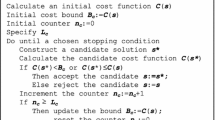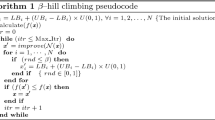Abstract
In this paper, we present an application of Tabu Search (TS) to the examination timetabling problem. One of the drawbacks of this meta-heuristic is related to the need of tuning some parameter (like tabu tenure) whose value affects the performance of the algorithm. The importance of developing an automatic procedure is clear considering that most of the users of timetabling software, like academic staff, do not have the expertise to conduct such tuning. The goal of this paper is to present a method to automatically manage the memory in the TS using a Decision Expert System. More precisely a Fuzzy Inference Rule Based System (FIRBS) is implemented to handle the tabu tenure based on two concepts, “Frequency” and “Inactivity”. These concepts are related respectively with the number of times a move is introduced in the tabu list and the last time (in number of iterations) the move was attempted and prevented by the tabu status. Computational results show that the implemented FIRBS handles well the tuning of the tabu status duration improving, as well, the performance of Tabu Search.
Similar content being viewed by others
References
Abdullah, S. (2006). Heuristic approaches for university timetabling problems. PhD thesis, University of Nottingham.
Abdullah, S., Ahmadi, S., Burke, E. K., & Dror, M. (2007). Investigating Ahuja-Orlin’s large neighbourhood search approach for examination timetabling. OR Spectrum, 29(2), 351–372.
Abramson, D., Krishnamoorthy, M., & Dang, H. (1999). Simulated annealing cooling schedules for the school timetabling problem. Asia-Pacific Journal of Operational Research, 16, 1–22.
Ahuja, R. K., Orlin, J. B., & Sharma, D. (2001). Multi-exchange neighborhood structures for the capacitated minimum spanning tree problem. Mathematical Programming, 91(1), 71–97.
Arani, T., & Lotfi, V. (1989). A three phased approach to final exam scheduling. IIE Transactions, 21(1), 86–96.
Asmuni, H., Burke, E. K., Garibaldi, J. M., & McCollum, B. (2004). In PATAT: Vol. 3616. Fuzzy multiple ordering criteria for examination timetabling.
Assilian, S., & Mamdani, E. H. (1974). An experiment in linguistic synthesis with a fuzzy logic controller. International Journal of Man-Machine Studies, 7(1), 1–13.
Awad, R., & Chinneck, J. (1998). Proctor assignment at Carleton University. Interfaces, 28(2), 58–71.
Brailsford, S. C., Potts, C. N., & Smith, B. M. (1999). Constraint satisfaction problems: algorithms and applications. European Journal of Operational Research, 119(3), 557–581.
Brélaz, D. (1979). New methods to color the vertices of a graph. Communications of the ACM, 22(4), 251–256.
Broder, S. (1964). Final examination scheduling. Communications of the ACM, 7, 494–498.
Burke, E. K., & Newall, J. P. (1999). A multistage evolutionary algorithm for the timetable problem. IEEE Transactions on Evolutionary Computation, 3(1), 63–74.
Burke, E. K., & Newall, J. P. (2003). Enhancing timetable solutions with local search methods. Lecture notes in computer science (pp. 195–206).
Burke, E., Jackson, K., Kingston, J. H., & Weare, R. (1997). Automated university timetabling: the state of the art. The Computer Journal, 40(9), 565–571.
Burke, E., Bykov, Y., Newall, J., & Petrovic, S. (2004a). A time-predefined local search approach to exam timetabling problems. IIE Transactions, 36(6), 509–528.
Burke, E. K., Kingston, J., & de Werra, D. (2004b). Applications to timetabling. In Handbook of graph theory (pp. 445–474).
Burke, E. K., Eckersley, A. J., McCollum, B., Petrovic, S., & Qu, R. (2006). Hybrid variable neighbourhood approaches to university exam timetabling. Technical report, Technical Report NOTTCS-TR-2006-2, School of CSiT, University of Nottingham.
Caprara, A., Fischetti, M., Guida, P. L., Monaci, M., Sacco, G., & Toth, P. (2001). Solution of real-world train timetabling problems. In Proceedings of the 34th annual Hawaii international conference on system sciences (p. 10).
Caramia, M., Dell Olmo, P., & Italiano, G. F. (2001). New algorithms for examination timetabling. Lecture notes in computer science (pp. 230–242).
Carter, M. W. (1986). A survey of practical applications of examination timetabling algorithms. Operations Research, 34(2), 193–202.
Carter, M. W., & Laporte, G. (1996). Recent developments in practical examination timetabling. In Selected papers from the first international conference on practice and theory of automated timetabling (pp. 3–21). London: Springer.
Carter, M. W., Laporte, G., & Chinneck, J. W. (1994). A general examination scheduling system. Interfaces, 24(3), 109–120.
Carter, M. W., Laporte, G., & Lee, S. Y. (1996). Examination timetabling: Algorithmic strategies and applications. The Journal of the Operational Research Society, 47(3), 373–383.
Casey, S., & Thompson, J. (2003). GRASPing the examination scheduling problem. Lecture notes in computer science (pp. 232–246).
Colorni, A., Dorigo, M., & Maniezzo, V. (1998). Metaheuristics for high school timetabling. Computational Optimization and Applications, 9(3), 275–298.
Corr, P. H., McCollum, B., McGreevy, M. A. J, & McMullan, P. (2006). A new neural network based construction heuristic for the examination timetabling problem. Lecture notes in computer science (Vol. 4193, p. 392).
Costa, D., & Hertz, A. (1998). Ants can colour graphs. The Journal of the Operational Research Society, 48, 295–305.
de Werra, D. (1985). An introduction to timetabling. European Journal of Operational Research, 19(2), 151–162.
Desroches, S., Laporte, G., & Rousseau, J. M. (1978). Horex: a computer program for the construction of examination schedules. INFOR Information Systems and Operational Research, 16, 294–298.
Di Gaspero, L. (2000). Recolour, shake and kick: A recipe for the examination timetabling problem. In Proceedings of the fourth international conference on the practice and theory of automated timetabling (pp. 404–407). Gent, Belgium
Di Gaspero, L., & Schaerf, A. (2001). Tabu search techniques for examination timetabling. Lecture notes in computer science (pp. 104–117).
Dowsland, K. A., & Thompson, J. M. (2005). Ant colony optimisation for the examination scheduling problem. The Journal of the Operational Research Society, 56(4), 426–438.
Dueck, G. (1993). New optimization heuristics: the great deluge algorithm and the record-to-travel. Journal of Computational Physics, 104, 86–92.
Easton, K., Nemhauser, G., & Trick, M. (2004). Sports scheduling. In: Handbook of scheduling: algorithms, models, and performance analysis.
Erben, W. (2001). A grouping genetic algorithm for graph colouring and exam timetabling. Lecture notes in computer science (pp. 132–158).
Glover, F. (1986). Future paths for integer programming and links to artificial intelligence. Computers and Operations Research, 13(5), 533–549.
Glover, F., & Laguna, M. (1997). Tabu search. Norwell: Kluwer Academic.
Hansen, P., & Mladenovic, N. (2001). Variable neighbourhood search. European Journal of Operational Research, 130, 449–467.
Hansen, M. P., & Vidal, R. V. V. (1995). Planning of high school examinations in Denmark. European Journal of Operational Research, 87(3), 519–534.
Isaai, M. T., & Singh, M. G. (2001). Hybrid applications of constraint satisfaction and meta-heuristics to railway timetabling: a comparative study. IEEE Transactions on Systems, Man and Cybernetics, Part C, 31(1), 87–95.
Kendall, G., & Mohd Hussin, N. (2003). In An investigation of a tabu search based hyper-heuristic for examination timetabling. Selected papers from MISTA (pp. 309–328).
Klir, G. J., & Yuan, B. (1995). Fuzzy sets and fuzzy logic. New York: Prentice Hall.
Merlot, L. T. G., Boland, N., Hughes, B. D., & Stuckey, P. J. (2003). A hybrid algorithm for the examination timetabling problem. Lecture notes in computer science (pp. 207–231).
Mladenovic, N., & Hansen, P. (1997). Variable neighbourhood search. Computers and Operations Research, 24(11), 1097–1100.
Morgenstern, C. (1989). Algorithms for general graph coloring. PhD thesis, Department of Computer Science, University of New Mexico.
Paquete, L. F., & Fonseca, C. M. (2001). A study of examination timetabling with multiobjective evolutionary algorithms. In Proceedings of the 4th metaheuristics international conference (MIC2001) (pp. 149–153).
Petrovic, S., & Burke, E. K. (2004). University timetabling. In Handbook of scheduling: algorithms, models, and performance analysis.
Petrovic, S., & Bykov, Y. (2003). A multiobjective optimisation technique for exam timetabling based on trajectories. Lecture notes in computer science (pp. 181–194).
Qi, X., Yang, J., & Yu, G. (2004). Scheduling problems in the airline industry. In Handbook of scheduling: algorithms, models, and performance analysis.
Qu, R., Burke, E. K., McCollum, B., Merlot, L. T. G., & Lee, S. Y. (2006). A survey of search methodologies and automated approaches for examination timetabling. Computer science (Technical Report No. NOTTCS-TR-2006-4).
Ribeiro Filho, G., & Lorena, L. A. N. (2001). A constructive evolutionary approach to school timetabling. In Lecture notes in computer science: Vol. 2037. Applications of evolutionary computing (pp. 130–139).
Schaerf, A. (1999). Local search techniques for large high school timetabling problems. IEEE Transactions on Systems, Man and Cybernetics, Part A, 29(4), 368–377.
Schimmelpfeng, K., & Helber, S. (2007). Application of a real-world university-course timetabling model solved by integer programming. OR-Spektrum, 29(4), 783–803.
Sugeno, M., & Kang, G. T. (1988). Structure identification of fuzzy model. Fuzzy Sets and Systems, 28(1), 15–33.
Takagi, T., & Sugeno, M. (1985). Fuzzy identification of systems and its applications to modelling and control. IEEE Transactions on Systems, Man, and Cybernetics, 15(1), 116–132.
Thompson, J. M., & Dowsland, K. A. (1996). Variants of simulated annealing for the examination timetabling problem. Annals of Operation Research, 63(1), 105–128.
Thompson, J. M., & Dowsland, K. A. (1998). A robust simulated annealing based examination timetabling system. Computers and Operations Research, 25(7–8), 637–648.
Trick, M. A. (2001). A schedule-then-break approach to sports timetabling Lecture notes in computer science (pp. 242–253).
White, G. M., & Xie, B. S. (2001). Examination timetables and tabu search with longer-term memory. Lecture notes in computer science (pp. 85–103).
Wood, D. C. (1968). A system for computing examination timetables. The Computer Journal, 11(1), 41–47.
Yang, Y., & Petrovic, S. (2005). A novel similarity measure for heuristic selection in examination timetabling. Lecture notes in computer science (Vol. 3616, p. 247).
Zadeh, L. A. (1965). Fuzzy sets. Information and Control, 8(3), 338–353.
Zadeh, L. A. (1975). The concept of a linguistic variable and its application to approximate reasoning, Part I. Information Sciences, 8(3), 199–249.
Zadeh, L. A. (1979). A theory of approximate reasoning. New York: Wiley.
Zimmermann, H. J. (1996). Fuzzy set theory and its applications. Norwell: Kluwer Academic.
Author information
Authors and Affiliations
Corresponding author
Rights and permissions
About this article
Cite this article
Pais, T.C., Amaral, P. Managing the tabu list length using a fuzzy inference system: an application to examination timetabling. Ann Oper Res 194, 341–363 (2012). https://doi.org/10.1007/s10479-011-0867-6
Published:
Issue Date:
DOI: https://doi.org/10.1007/s10479-011-0867-6




